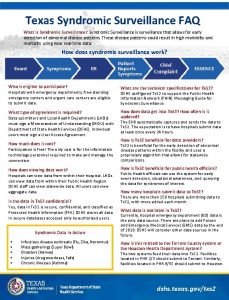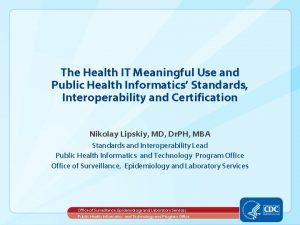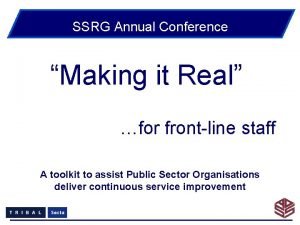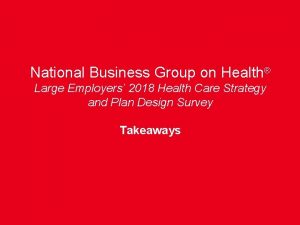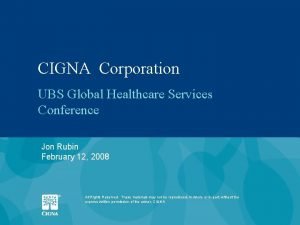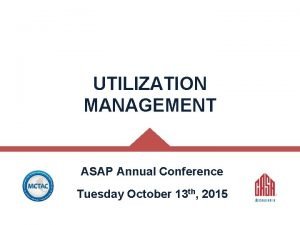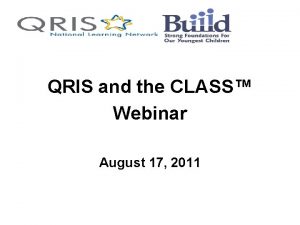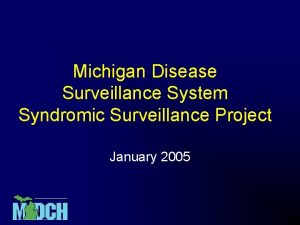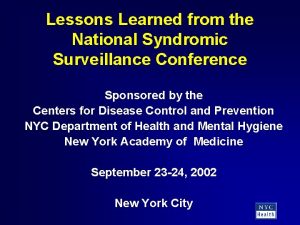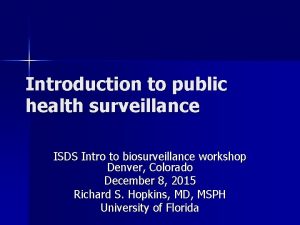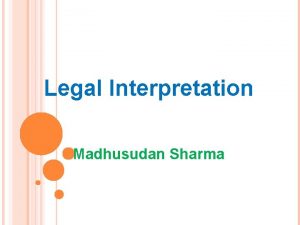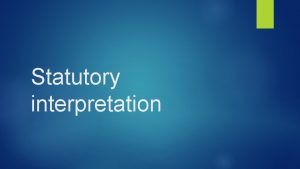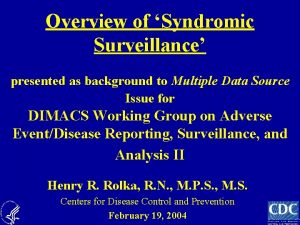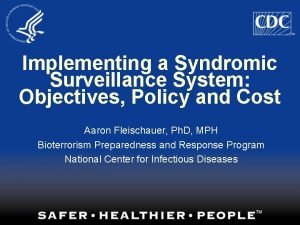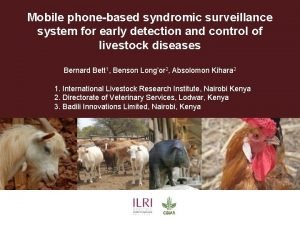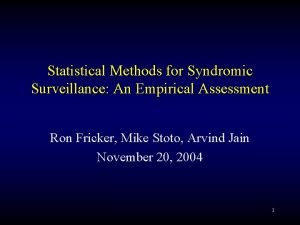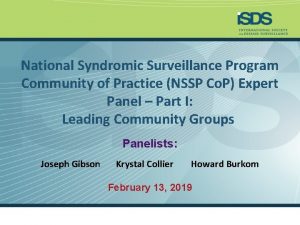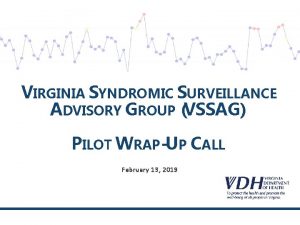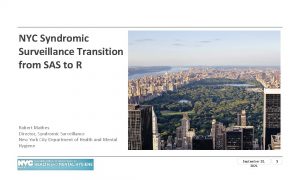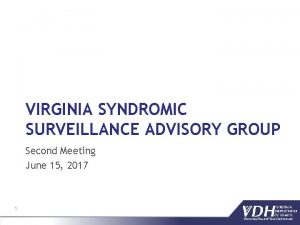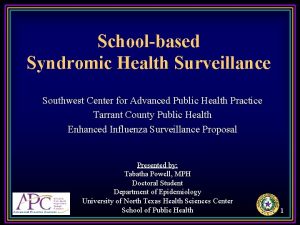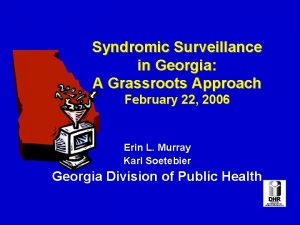Syndromic Surveillance Analysis Interpretation 2018 ISDS Conference David























- Slides: 23

Syndromic Surveillance Analysis & Interpretation 2018 ISDS Conference David Swenson New Hampshire, DHHS, DPHS January 31, 2018

Agenda Develop Protocols and Begin Surveillance Conduct Public Health Monitoring Characterize, Interpret, and Analyze Data Refine Analysis Notify and Engage Partners/Leadership Conduct Reach-back Conduct Response Management

Syndromic Surveillance Analysis & Interpretation Develop Protocols and Begin Surveillance

Syndromic Surveillance Analysis & Interpretation Develop protocols and begin surveillance Establish protocols to monitor sources and to detect and analyze the importance of anomalies in data. Routine monitoring may include hospital and lab data, alerts for syndromes, time of alert, ZIP codes and maps, and specific free-text queries. Performed by Public Health syndromic surveillance coordinator, PH nurse, epidemiologist or other PHAdesignated staff Compare syndromic with other data sources (e. g. , reportable disease ED data with lab or poison control data).

Syndromic Surveillance Analysis & Interpretation Conduct Population Health Monitoring

Syndromic Surveillance Analysis & Interpretation Conduct Population Health Monitoring Situational awareness Daily monitoring? Mass gathering? Sharing data depends on jurisdiction (potential access to local/state/region/national data)? Event detection - automated alerting for health threats Reportable disease (Pertussis) outbreaks Environmental exposure (heat/cold/emergency events) Monitoring emergency situations (such as with Opioids) Response management

Syndromic Surveillance Analysis & Interpretation Characterize, Interpret, and Analyze Data

Syndromic Surveillance Analysis & Interpretation Characterize, Interpret, and Analyze Data Assess epidemiologic characteristics (person, place, time) Does the time series show an increasing trend—continuity of the increase? Have there been multiple days with count data at or near this level? Across different strata (i. e. , age groups, hospitals)? Do the data show the same pattern when viewed as a proportion? What is the magnitude of the difference from previous day(s)? Is this part of an expected seasonal increase? Out of season? How large is the ratio of observed-to-expected patients for a given day? How does the time series trend compare to previous years?

Syndromic Surveillance Analysis & Interpretation Characterize, Interpret, and Analyze Data - Check Line-Level Details Is there a pattern by age, sex, or patient ZIP code? Is there a pattern in the wording of the chief complaints? When available, what do the discharge diagnosis and discharge disposition suggest (admitted, discharged)? Are there a number of visits with similar presentation times? And do these individuals also cluster by the emergency department they visited or by their ZIP code? If a cluster is unlikely, resume monitoring. But if a cluster is likely and might be of public health significance, use your follow-up protocol.

Syndromic Surveillance Analysis & Interpretation Geo Spatial Analysis Represent data in Maps (geographically) by Facility, or Patient Zip Code or Residence location) Represent spatial-oriented spikes of activity in severity ranges Correlate data with other data sources Social Vulnerability data (lack of education, low income, single parent, unemployed, etc. ) What relationships show up?

Syndromic Surveillance Analysis & Interpretation Refine Analysis The PHSS analyst or designated staff determines if the results have been refined to the point where the analyst is able to draw meaning out of the results, draw conclusions or interpretations, has excluded all null hypotheses, and is satisfied all of the important questions have been asked. If the answer is no, then the analyst continues the manual analysis, interpretation, and characterization until a meaningful result is attained or null hypothesis is proved. If the answer is yes, then the results have been refined enough so that the results have meaning and the analyst is able to contribute to or advise on next steps.

Syndromic Surveillance Analysis & Interpretation Responsible Data Caveats Responsible presentation of the data might include the following: Use percent over counts Focus on trends not magnitudes Syndromes can vary and are not 100% sensitive or specific Geographic comparisons should be done with caution if underlying data is being compared

Syndromic Surveillance Analysis & Interpretation Responsible Data Caveats Responsible presentation of the data is rarely discussed within the Surveillance System (Sy. S) community – answers to the following questions are needed What should standardized language be that accompanies your jurisdictional Sy. S data? How should we best share syndromic surveillance data that is often incomplete and subject to inter-hospital variability? What kinds of reporting would the Sy. S community like to see?

Syndromic Surveillance Analysis & Interpretation Apply follow-up protocol (response)

Syndromic Surveillance Analysis & Interpretation Conduct Reach-Back PHSS analyst does if results and analysis thus far, with the context, and the health condition of interest warrants a response

Syndromic Surveillance Analysis & Interpretation Response Management Disseminate SS Information Provide Summary Information to Situational Report (SITREP) Send Health Alert Provide Information to PIO Inform Health Care Providers Activate PH / Preparedness and Response Resources Launch a Formal PH Investigation

Syndromic Surveillance Analysis & Interpretation Apply follow-up protocol (response) Gather additional information from hospitals. Based on available data sources and any additional communications with a hospital(s) or patients, was this an outbreak or cluster of public health significance? Follow standard outbreak investigation steps, implement control measures or broadcast communications if appropriate, and provide recommendations. Summarize your concerns or findings and alert colleagues at the local, regional, or state level.

Syndromic Surveillance Analysis & Interpretation Notify and Engage Partners / Leadership

Syndromic Surveillance Analysis & Interpretation Notify and Engage Partners / Leadership

Syndromic Surveillance Analysis & Interpretation Notify and Engage Partners / Leadership Relevant partners are engaged so that a determination can be made on next steps of whether to continue to escalate the issue or to abort. Partners include local, regional, state authority, colleague or designee. Partners include both public health and preparedness. The partners engaged vary across jurisdictions and level of authority. If the issue is categorized as high level priority (based on health condition of interest, outside influences, purpose, and context) then leadership is engaged. If not, then the PHSS unit and relevant engaged partners review and confirm the conclusions.

Syndromic Surveillance Analysis & Interpertation References Centers for Disease Control and Prevention. Syndromic Surveillance on the Epidemiologist’s Desktop: Making Sense of Much Data; Figure 1, Theoretical framework for response protocols in use of syndromic surveillance systems. MMWR 2005; 54(Suppl); 141– 6. 1 2 ESSENCE User Guide [Internet]. Version 1. 0. Florida Department of Health, Bureau of Epidemiology. 2010. Appendix 1: Flowchart for analysis and response to syndromic surveillance data; [cited 2016 Nov 22]. p. 56. Available from www. floridahealth. gov/diseases-and-conditions/disease-reporting-and -management/disease-reporting-and-surveillance/_documents/florida-essence-user-guide. pdf International Society for Disease Surveillance. Final recommendation: Core processes and EHR requirements for public health syndromic surveillance [Internet]. Figure 5, Task flow diagram of BP 1 —Conduct syndrome-based population health monitoring: Monitor and assist in the assessment, detection, communication, and response to public health conditions of interest; 2011 Jan [cited 2018 Jan 1]; Available from: https: //knowledge-repository. s 3. amazonaws. com/recommendations/ Recommendation_2011_January_Core%20 Processes%20 and%20 EHR%20 Requirements%20 for%20 P ublic%20 Health%20 Syndromic%20 Surveillance. pdf 3

Syndromic Surveillance Analysis & Interpertation Questions?

Contact Information David Swenson AHEDD Project Manager Infectious Disease Surveillance Section Phone: (603) 271 -7366 Email: David. Swenson@dhhs. nh. gov
 Texas syndromic surveillance
Texas syndromic surveillance Syndromic surveillance
Syndromic surveillance Webový portál isds
Webový portál isds How does interpretation b differ from interpretation a
How does interpretation b differ from interpretation a B a f c j e
B a f c j e Oracle69 portfolio
Oracle69 portfolio Annual fuze conference
Annual fuze conference Cmaa conference 2018
Cmaa conference 2018 Asha conference 2018 boston
Asha conference 2018 boston Workforce planning conference 2018
Workforce planning conference 2018 Lifelong learning conference 2018
Lifelong learning conference 2018 Pmi houston chapter
Pmi houston chapter Adss conference 2018
Adss conference 2018 Freedom pay credit card processing
Freedom pay credit card processing Financial risk management conference 2018
Financial risk management conference 2018 National business group on health conference 2018
National business group on health conference 2018 Pfa conference 2018
Pfa conference 2018 Cigna conference 2018
Cigna conference 2018 Boston library consortium
Boston library consortium Eacs conference 2018
Eacs conference 2018 Pat lincourt oasas
Pat lincourt oasas Teachstone class video library
Teachstone class video library Bccie summer conference 2018
Bccie summer conference 2018 Tlffra conference 2018
Tlffra conference 2018
